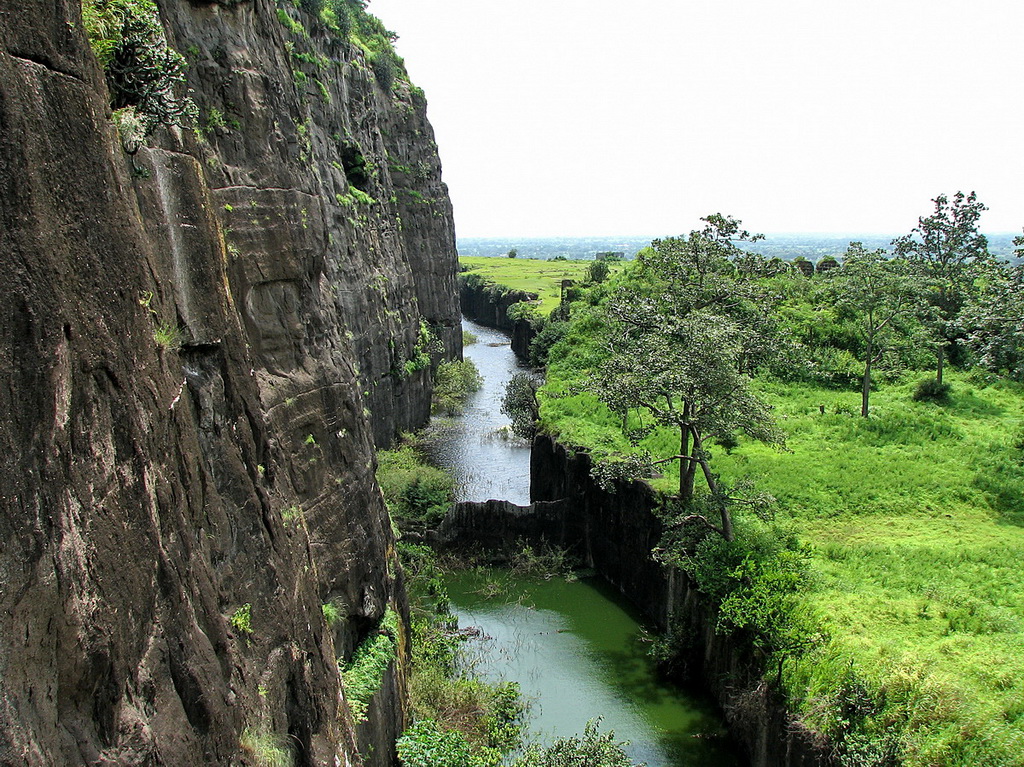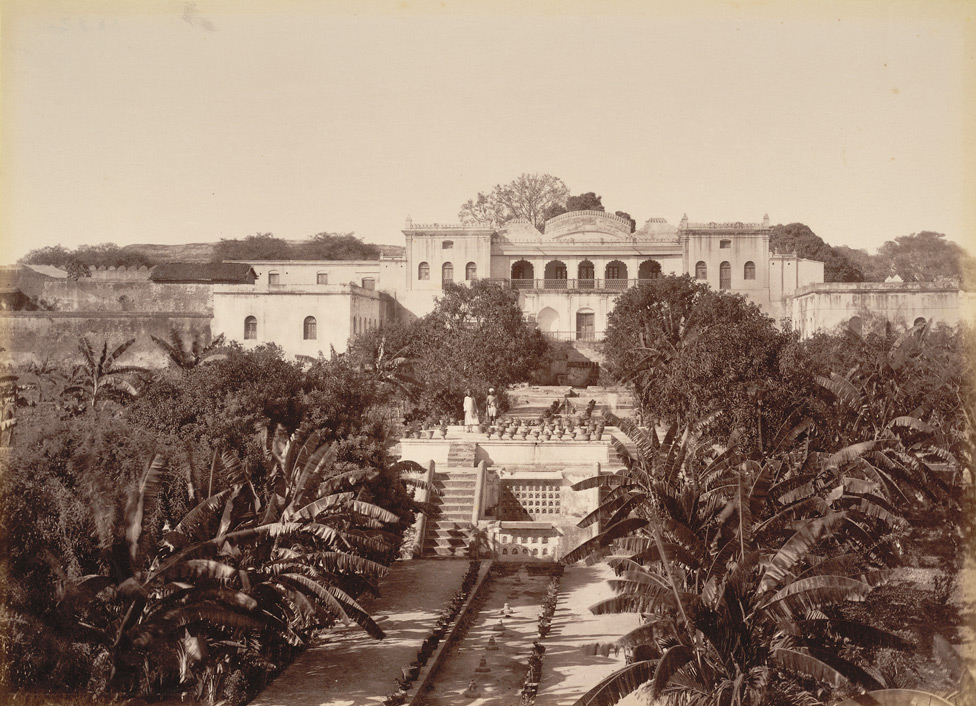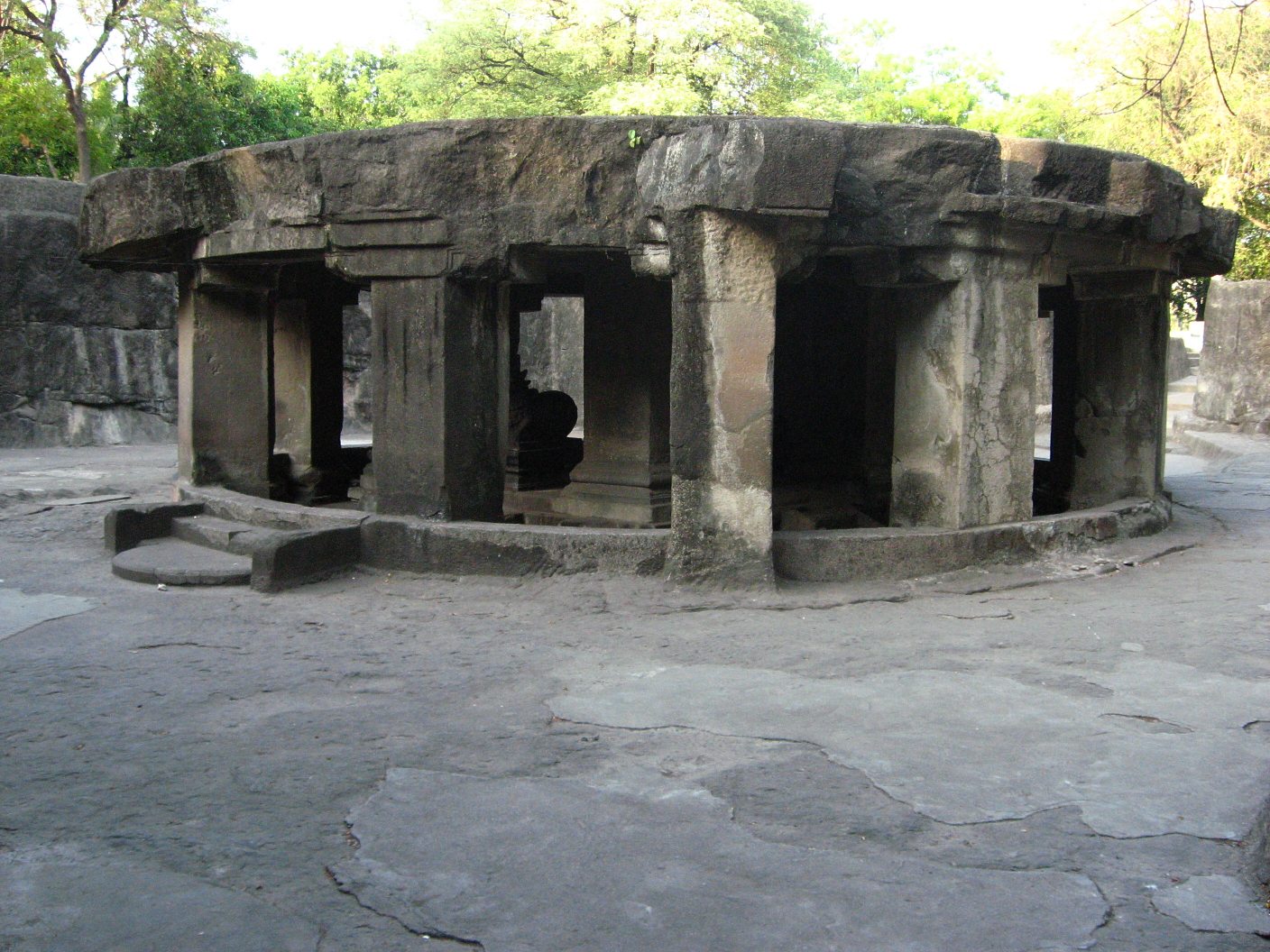|
Devagiri
Daulatabad Fort, originally Deogiri Fort, is a historic fortified citadel located in Daulatabad village near Aurangabad, Maharashtra, India. It was the capital of the Yadavas (9th century – 14th century CE), for a brief time the capital of the Delhi Sultanate (1327–1334), and later a secondary capital of the Ahmadnagar Sultanate (1499–1636). Around the 6th century CE, Devagiri emerged as an important uplands town near present-day Sambhajinagar, along caravan routes going towards western and southern India. The historical triangular fortress in the city was initially built around 1187 by the first Yadava monarch, Bhillama V. In 1308, the city was annexed by Alauddin Khalji of the Delhi Sultanate, which ruled over some parts of the northern India. In 1327, Muhammad bin Tughluq of the Delhi Sultanate renamed Devagiri as Daulatabad and shifted his imperial capital to the city from Delhi, ordering a mass migration of Delhi's population to the now Daulatabad. However, Muham ... [...More Info...] [...Related Items...] OR: [Wikipedia] [Google] [Baidu] |
Alauddin Khalji's Conquest Of Devagiri
The conquest of Devagiri occurred around 1308, after the Delhi Sultanate ruler Alauddin Khalji sent a large army led by his general Malik Kafur to Devagiri, the capital of the Yadava king Ramachandra. Alauddin had earlier raided Devagiri in 1296, and forced Ramachandra to pay him tribute. However, Ramachandra had discontinued tribute payments, and had given asylum to the Vaghela king Karna, whom Alauddin had ousted from Gujarat in 1304. A section of the Delhi army, commanded by Alp Khan, invaded Karna's principality in the Yadava kingdom, and captured the Vaghela princess Devaladevi, who later married Alauddin's son Khizr Khan. Another section, commanded by Malik Kafur captured Devagiri after a weak resistance by the defenders. Ramachandra agreed to become a vassal of Alauddin, and later, aided Malik Kafur in the Sultanate's invasions of the southern kingdoms. Date There is some confusion over the date of Alauddin's second invasion of Devagiri. His courtier Amir Khus ... [...More Info...] [...Related Items...] OR: [Wikipedia] [Google] [Baidu] |
Seuna (Yadava) Dynasty
The Seuna, Sevuna, or Yadava, Yadavas of Devagiri (IAST: Seuṇa, –1317) was a medieval Indian dynasty, which at its peak ruled a realm stretching from the Narmada River, Narmada river in the north to the Tungabhadra river in the south, in the western part of the Deccan region. Its territory included present-day Maharashtra, North Karnataka, northern Karnataka and parts of Madhya Pradesh, from its capital at Devagiri (present-day Daulatabad, Maharashtra, Daulatabad in modern Aurangabad district, Maharashtra, Chhatrapati Sambhajinagar district, Maharashtra). The Yadavas initially ruled as feudatories of the Western Chalukyas. Around the middle of the 12th century, as the Chalukya power waned, the Yadava king Bhillama V declared independence. The Yadavas reached their peak under Simhana, Simhana II, and flourished until the early 14th century, when it was annexed by the Khalji dynasty of the Delhi Sultanate in 1308 CE. Etymology The Seuna dynasty claimed descent from the Yad ... [...More Info...] [...Related Items...] OR: [Wikipedia] [Google] [Baidu] |
Yadava Dynasty
The Seuna, Sevuna, or Yadavas of Devagiri (IAST: Seuṇa, –1317) was a medieval Indian dynasty, which at its peak ruled a realm stretching from the Narmada river in the north to the Tungabhadra river in the south, in the western part of the Deccan region. Its territory included present-day Maharashtra, northern Karnataka and parts of Madhya Pradesh, from its capital at Devagiri (present-day Daulatabad in modern Chhatrapati Sambhajinagar district, Maharashtra). The Yadavas initially ruled as feudatories of the Western Chalukyas. Around the middle of the 12th century, as the Chalukya power waned, the Yadava king Bhillama V declared independence. The Yadavas reached their peak under Simhana II, and flourished until the early 14th century, when it was annexed by the Khalji dynasty of the Delhi Sultanate in 1308 CE. Etymology The Seuna dynasty claimed descent from the Yadavas and therefore, its kings are often referred to as the "Yadavas of Devagiri". The correct na ... [...More Info...] [...Related Items...] OR: [Wikipedia] [Google] [Baidu] |
Alauddin Khalji
Alauddin Khalji (; ), born Ali Gurshasp, was a ruler from the Khalji dynasty that ruled the Delhi Sultanate in the Indian subcontinent. Alauddin instituted a number of significant administrative changes in the Delhi Sultanate, related to revenue reforms of Alauddin Khalji, revenues, market reforms of Alauddin Khalji, price controls, and rebellions against Alauddin Khalji#Measures for preventing rebellions, society. He also successfully fended off several Mongol invasions of India. Alauddin was a nephew and a son-in-law of his predecessor Jalal ud din Firuz Khalji, Jalaluddin. When Jalaluddin became the Sultan of Delhi Khalji Revolution, after deposing the Mamluk dynasty (Delhi), Mamluks, Alauddin was given the position of ''Amir-i-Tuzuk'' (equivalent to master of ceremonies). After suppressing a revolt against Jalaluddin, Alauddin obtained the governorship of Kara-Manikpur, Kara in 1291, and the governorship of Awadh in 1296, after a profitable Alauddin Khalji's raid on Bhilsa, r ... [...More Info...] [...Related Items...] OR: [Wikipedia] [Google] [Baidu] |
Daulatabad Fort
Daulatabad Fort, originally Deogiri Fort, is a historic fortified citadel located in Daulatabad village near Aurangabad, Maharashtra, India. It was the capital of the Yadavas (9th century – 14th century CE), for a brief time the capital of the Delhi Sultanate (1327–1334), and later a secondary capital of the Ahmadnagar Sultanate (1499–1636). Around the 6th century CE, Devagiri emerged as an important uplands town near present-day Sambhajinagar, along caravan routes going towards western and southern India. The historical triangular fortress in the city was initially built around 1187 by the first Yadava monarch, Bhillama V. In 1308, the city was annexed by Alauddin Khalji of the Delhi Sultanate, which ruled over some parts of the northern India. In 1327, Muhammad bin Tughluq of the Delhi Sultanate renamed Devagiri as Daulatabad and shifted his imperial capital to the city from Delhi, ordering a mass migration of Delhi's population to the now Daulatabad. However, Muhammad ... [...More Info...] [...Related Items...] OR: [Wikipedia] [Google] [Baidu] |
Aurangabad
Aurangabad (), officially renamed as Chhatrapati Sambhajinagar in 2023, is a city in the Indian state of Maharashtra. It is the administrative headquarters of Aurangabad district and is the largest city in the Marathwada region. Located on a hilly upland terrain in the Deccan Traps, Aurangabad is the fifth-most populous urban area in Maharashtra, after Mumbai, Pune, Nagpur and Nashik, with a population of 1,175,116. The city is a major production center of cotton textile and artistic silk fabrics. Several prominent educational institutions, including Dr. Babasaheb Ambedkar Marathwada University, are located in the city. The city is also a popular tourism hub, with attractions like the Ajanta and Ellora caves lying on its outskirts, both of which have been designated as UNESCO World Heritage Sites since 1983, the Aurangabad Caves, Devagiri Fort, Grishneshwar Temple, Jama Mosque, Bibi Ka Maqbara, Himayat Bagh, Panchakki and Salim Ali Lake. Historically, there were 52 ... [...More Info...] [...Related Items...] OR: [Wikipedia] [Google] [Baidu] |
Bhillama V
Bhillama V (r. c. 1175–1191 CE) was the first sovereign ruler of the Seuna (Yadava) dynasty of Deccan region in India. A grandson of the Yadava king Mullagi, he carved out a principality in present-day Maharashtra by capturing forts in and around the Konkan region. Around 1175 CE, he grabbed the Yadava throne, supplanting the descendants of his uncle and an usurper. Over the next decade, he ruled as a nominal vassal of the Chalukyas of Kalyani, raiding the Gujarat Chaulukya and Paramara territories. After the fall of the Chalukya power, he declared sovereignty around 1187 CE, and fought with the Hoysala king Ballala II for control of the former Chalukya territory in present-day Karnataka. Around 1189 CE, he defeated Ballala in a battle at Soratur, but two years later, Ballala defeated him decisively. Rise to power According to Bhillama's Gadag inscription, he was a son of Karna, and a grandson of the Yadava ruler Mallugi. The 13th century Yadava court poet Hemadri ... [...More Info...] [...Related Items...] OR: [Wikipedia] [Google] [Baidu] |
Delhi Sultanate
The Delhi Sultanate or the Sultanate of Delhi was a Medieval India, late medieval empire primarily based in Delhi that stretched over large parts of the Indian subcontinent for more than three centuries.Delhi Sultanate Encyclopædia Britannica The sultanate was established around in the former Ghurid Empire, Ghurid territories in India. The sultanate's history is generally divided into five periods: Mamluk dynasty (Delhi), Mamluk (1206–1290), Khalji dynasty, Khalji (1290–1320), Tughlaq dynasty, Tughlaq (1320–1414), Sayyid dynasty, Sayyid (1414–1451), and Lodi dynasty, Lodi (1451–1526). It covered large swaths of territory in modern-day India, Pakistan, Bangladesh, as well as some parts of southern Nepal. The foundation of the Sultanate was established by the Ghurid conqueror Muhammad of Ghor, Muhammad ... [...More Info...] [...Related Items...] OR: [Wikipedia] [Google] [Baidu] |
Muhammad Bin Tughluq
Muhammad bin Tughluq (; ; 1290 – 20 March 1351), or Muhammad II, also named Jauna Khan as Crown Prince, further known by his epithets, The Eccentric Prince, or The Mad Sultan, was the eighteenth Sultan of Delhi. He reigned from 4 February 1325 until his death in 1351. The sultan was the eldest son of Ghiyath al-Din Tughluq, founder of the Tughlaq dynasty. In 1321, the young Muhammad was sent by his father to the Deccan Plateau to fight a military campaign against the Kakatiya dynasty. In 1323, the future sultan successfully laid siege upon the Kakatiya capital in Warangal. This victory over King Prataparudra ended the Kakatiya dynasty. Muhammad ascended to the Delhi throne upon his father's death in 1325. Muhammad bin Tughluq had an interest in medicine. He was also skilled in several languages: Persian, Hindavi, Arabic, Sanskrit and Turkic. Ibn Battuta, the famous traveler and jurist from Morocco, wrote in his book about his time at the Sultan's court. Early life Mu ... [...More Info...] [...Related Items...] OR: [Wikipedia] [Google] [Baidu] |
Khuldabad
Khuldabad, also called Rauza, is a city (municipal council) and a Taluka of Aurangabad district in the Indian state of Maharashtra. It is known as the Valley of Saints, or the Abode of Eternity, because in the 14th century, several Sufi saints chose to reside here. The Bhadra Maruti Temple and Dargah of Zar Zari Zar Baksh, Shaikh Burhan ud-din Gharib Chisti and Shaikh Zain-ud-din Shirazi, along with the tomb of the Mughal emperor Aurangzeb and his trusted General Asif Jah I, the first Nizam of Hyderabad, are located in this town. It is a holy and spiritual city of Islamic saints. The place has famous Bhadra Maruti Temple. People come from Chhatrapati Sambhaji Nagar and nearby places by walk for offering puja on Hanuman Jayanti and on Saturdays in Marathi calendar month "Shravan". Nearby is the Valley of the Saints, which is purported to contain the graves of 1500 Sufi saints. Etymology The name 'Khuldabad' translates to 'Abode of Eternity'. It is derived from the ... [...More Info...] [...Related Items...] OR: [Wikipedia] [Google] [Baidu] |
Pune
Pune ( ; , ISO 15919, ISO: ), previously spelled in English as Poona (List of renamed Indian cities and states#Maharashtra, the official name until 1978), is a city in the state of Maharashtra in the Deccan Plateau, Deccan plateau in Western India. It is the administrative headquarters of the Pune district, and of Pune division. In terms of the total amount of land under its jurisdiction, Pune is the largest city in Maharashtra, with a geographical area of 516.18 sq km, though List of cities in India by population, by population it comes in a distant second to Mumbai. According to the 2011 Census of India, Pune has 7.2 million residents in the metropolitan region, making it the List of metropolitan areas in India, seventh-most populous metropolitan area in India. The city of Pune is part of Pune Metropolitan Region. Pune is one of the largest IT hubs in India. It is also one of the most important Automotive industry in India, automobile and Manufacturing in India, manufacturin ... [...More Info...] [...Related Items...] OR: [Wikipedia] [Google] [Baidu] |







